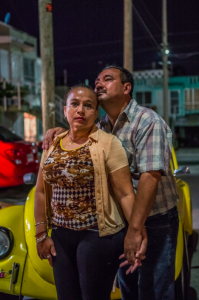I am writing my article over the chaos that is happening in Honduras over the election that happened on Nov. 26th. The article I read was over the riot police in Honduras, and how they have decided to strike, and not enforce the curfew because they believe that it makes them take sides in this heated political issue. On November 26th candidate Salvador Nasralla and Juan Orlando Hernandez went head to head in the Honduras presidential election where the two candidates tied. The Honduras electoral commission has started a recount of ballets. But supporters of Nasralla believe that Hernandez is using his current power as president to sway the vote his way. The supporters of both candidates have started protesting, sometimes making the protests violent, which is why the curfew was put into place. During the recounting of the ballets the Electoral commission had to stop the recounts because they said they had a computer failure which resulted in lost ballets. The only people allowed to be out during the curfew is people on the campaign, police, emergency workers, and government employees. The reason that people are protesting is that there is to believed to be major voter fraud occurring.
Valdes , Gustavo, Dakin Andone, and Marilia Brocchetto. “Honduras Begins vote recount in unresovled election .” December 4, 2017. Accessed December 5, 2017. http://www.cnn.com/2017/12/02/americas/honduras-unrest-post-election/index.html.
“Honduras election: Army given more power to quash unrest.” December 2, 2017. Accessed December 5, 2017. http://www.bbc.com/news/world-latin-america-42205180.
“Honduras police revolt amid tension over election .” December 5, 2017. Accessed December 5, 2017. http://www.bbc.com/news/world-latin-america-42236202.





 Over the weeks in class, we have seen several Noticia articles where an injustice or injustices have been targeted at specific Latin American countries and peoples. We talk a lot about how that affects their cultures and their identities and how many of those people don’t have the power to fight back against the issues. I think this article is so important because instead of letting the issue of gender violence exist as a part of Guatemalan culture and identity as the article suggests, these women have chosen to speak out against the “norms” and speak to the women who need help. I feel like the women apart of the AGIMS organization are attempting to replace this negative aspect of Guatemalan identity and replace it with one that shares the value of community, support, and unity for everyone in the country, whether they are indigenous or not and regardless of their gender. We haven’t explicitly talked much about replacing parts of cultural identity in this class but I think it’s important especially in cases like these when a negative identifier of a community should be replaced.
Over the weeks in class, we have seen several Noticia articles where an injustice or injustices have been targeted at specific Latin American countries and peoples. We talk a lot about how that affects their cultures and their identities and how many of those people don’t have the power to fight back against the issues. I think this article is so important because instead of letting the issue of gender violence exist as a part of Guatemalan culture and identity as the article suggests, these women have chosen to speak out against the “norms” and speak to the women who need help. I feel like the women apart of the AGIMS organization are attempting to replace this negative aspect of Guatemalan identity and replace it with one that shares the value of community, support, and unity for everyone in the country, whether they are indigenous or not and regardless of their gender. We haven’t explicitly talked much about replacing parts of cultural identity in this class but I think it’s important especially in cases like these when a negative identifier of a community should be replaced.
